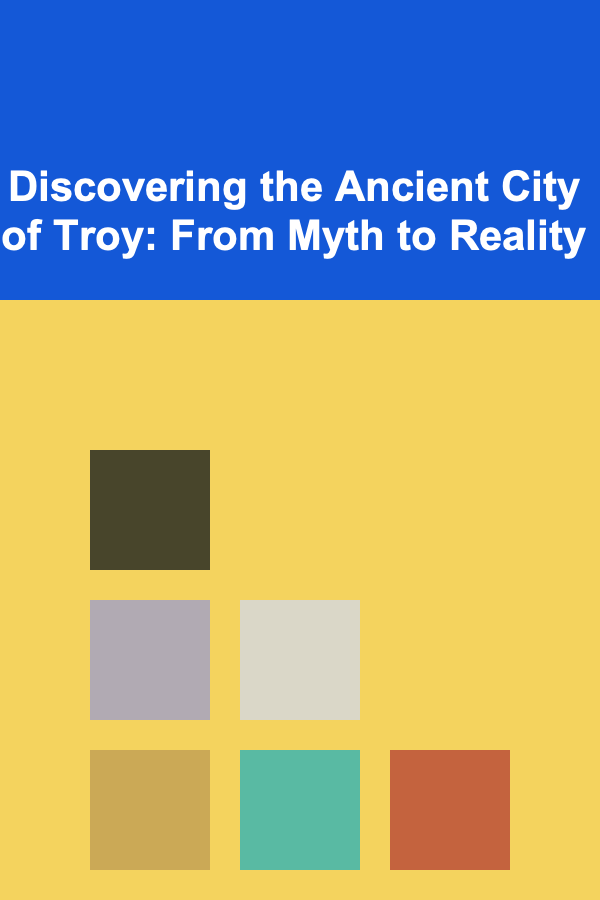
Discovering the Ancient City of Troy: From Myth to Reality
ebook include PDF & Audio bundle (Micro Guide)
$12.99$6.99
Limited Time Offer! Order within the next:

The story of Troy, immortalized in Homer's epic poems, the Iliad and the Odyssey, has captivated imaginations for millennia. Tales of heroic warriors, divine interventions, and the infamous Trojan Horse have shaped our understanding of ancient Greece and its complex relationship with the East. But was Troy merely a figment of poetic imagination, or did a real city stand as the backdrop for these legendary events? This article delves into the fascinating journey of discovering the ancient city of Troy, tracing the clues from myth and literature to archaeological excavation and scientific analysis.
The Enduring Allure of the Trojan War
The Trojan War, as recounted by Homer, centers on the abduction of Helen, wife of King Menelaus of Sparta, by Paris, prince of Troy. This act sparked a decade-long siege of Troy by a coalition of Greek forces, culminating in the city's fall through the cunning trick of the Trojan Horse. The war involved a cast of larger-than-life characters, including Achilles, Hector, Odysseus, and Agamemnon, whose deeds and struggles have become archetypal representations of human virtues and flaws.
For centuries, the Iliad and the Odyssey were considered largely mythological narratives, providing entertainment and moral lessons but lacking historical veracity. While their poetic structure and fantastical elements suggested a degree of embellishment, a persistent undercurrent of belief held that the poems contained a kernel of historical truth. The question lingered: could a city like Troy, as described by Homer, have actually existed?
Heinrich Schliemann and the Quest for Troy
The modern rediscovery of Troy is inextricably linked to the name of Heinrich Schliemann, a German businessman and amateur archaeologist. Schliemann possessed an unwavering belief in the historical accuracy of Homer's epics. He passionately believed that Troy was a real place and that its ruins lay buried somewhere in the Troad region of northwestern Turkey (historically known as Asia Minor).
Driven by his conviction and fueled by his personal fortune, Schliemann embarked on his quest in 1870. He focused his attention on a prominent mound known as Hisarlik, near the modern-day town of Tevfikiye. Unlike many of his contemporaries who approached archaeology as a treasure hunt, Schliemann, despite his sometimes-questionable methods, was motivated by a genuine desire to prove the historical basis of the Trojan War.
Schliemann's initial excavations at Hisarlik were characterized by a rather destructive approach. He dug deep trenches through the mound, often disregarding the layers of archaeological strata. While his enthusiasm was undeniable, his lack of formal archaeological training resulted in the loss of valuable contextual information. He essentially bulldozed through the upper layers, searching for what he believed to be the "Troy of Homer."
In 1873, Schliemann made a sensational discovery, unearthing a cache of gold, silver, and bronze artifacts, which he famously dubbed "Priam's Treasure." He believed that these treasures belonged to the legendary King Priam of Troy, further solidifying his conviction that he had found the city described by Homer. The discovery catapulted Schliemann to international fame, but also sparked controversy, particularly concerning the methods he employed and the rightful ownership of the artifacts.
While Schliemann's methods were far from ideal by modern standards, his work was undeniably groundbreaking. He proved that Hisarlik was indeed the site of an ancient city, occupied over a long period of time. His discovery ignited a renewed interest in the archaeology of the Troad and laid the foundation for future, more systematic investigations.
Heinrich Schliemann
Wilhelm Dörpfeld and the Refinement of Archaeological Understanding
Following Schliemann's death in 1890, the responsibility for excavating Troy fell to Wilhelm Dörpfeld, a more methodical and scientifically trained archaeologist. Dörpfeld worked with Schliemann during the later stages of the excavations and brought a much-needed level of rigor to the project.
Dörpfeld's primary contribution was the meticulous analysis and differentiation of the various layers of occupation at Hisarlik. He identified nine distinct cities, each built upon the ruins of its predecessor, spanning a period from the Early Bronze Age to the Roman era. He meticulously documented the architecture, pottery, and other artifacts associated with each layer, providing a more nuanced understanding of the site's history.
Dörpfeld initially believed that Troy VI, a large, well-fortified city dating to the Late Bronze Age, was the Troy of Homer. This layer exhibited evidence of destruction, possibly caused by an earthquake, which could have provided the inspiration for the epic siege. He identified impressive defensive walls and a sophisticated urban layout, features that seemed to align with Homer's descriptions.
However, Dörpfeld's interpretation was later challenged by subsequent excavations. While Troy VI showed signs of prosperity and potential destruction, its timeline did not perfectly match the traditional dating of the Trojan War.
Carl Blegen and the Search for Homeric Troy
In the 1930s, Carl Blegen, an American archaeologist from the University of Cincinnati, continued the excavations at Troy. Blegen adopted an even more systematic approach, employing meticulous stratigraphic methods and documenting every find with great care.
Blegen challenged Dörpfeld's identification of Troy VI as the Homeric city. After careful analysis, Blegen proposed that Troy VIIa, a later settlement that showed evidence of fire and destruction, was a more likely candidate. Troy VIIa dates to approximately 1250 BC, a period that aligns more closely with the traditional dating of the Trojan War.
While Troy VIIa was significantly smaller and less impressive than Troy VI, Blegen argued that its destruction by fire and its relative proximity to the traditional timeframe made it a more plausible setting for the events described in the Iliad. He found evidence of hastily constructed dwellings and overcrowded conditions, suggesting a period of stress and decline.
The debate over which city represents the "true" Troy of Homer continues to this day. The archaeological evidence is complex and open to interpretation. It is important to remember that the Iliad is a work of poetry, not a historical document. It likely draws upon a combination of historical events, legends, and mythical elements.
The University of Tübingen Excavations and Modern Research
Since 1988, excavations at Troy have been conducted by the University of Tübingen under the direction of Manfred Korfmann and later Ernst Pernicka. These excavations have employed cutting-edge archaeological techniques, including geophysical surveys, ground-penetrating radar, and advanced dating methods.
One of the most significant findings of the Tübingen excavations was the discovery of a lower town surrounding the citadel of Troy. This lower town, which was much larger than previously thought, suggests that Troy was a significant urban center with a substantial population. The discovery challenges the earlier view of Troy as a relatively small and insignificant settlement.
The Tübingen team has also focused on analyzing the environmental context of Troy, studying pollen samples and animal bones to reconstruct the ancient landscape and economy. This research has revealed that Troy was located in a strategically important region, controlling access to the Dardanelles Strait and serving as a hub for trade and communication between Europe and Asia.
Furthermore, scientific analysis of human remains found at Troy has provided insights into the diet, health, and origins of the city's inhabitants. Isotopic analysis of teeth has revealed that some individuals were not local to the Troad region, suggesting migration and trade connections with other areas.
The University of Tübingen's excavations have significantly enhanced our understanding of Troy, revealing a complex and dynamic city that played a vital role in the ancient world. Their work has demonstrated the importance of interdisciplinary research, combining archaeological excavation with scientific analysis to reconstruct the past.
The Trojan Horse: Myth or Reality?
The story of the Trojan Horse remains one of the most enduring and iconic elements of the Trojan War narrative. The idea of the Greeks concealing soldiers inside a giant wooden horse and presenting it as a gift to the Trojans is a brilliant example of cunning and deception.
While there is no archaeological evidence to support the existence of a literal wooden horse, many scholars believe that the story may be a metaphor for a more complex reality. Several theories have been proposed to explain the origin of the Trojan Horse legend:
- Siege Engines: Some historians suggest that the "horse" may have been a siege engine disguised to resemble a horse. Ancient siege engines were often covered with animal hides or other materials for protection.
- Earthquake: Another theory proposes that the "horse" was a symbol of Poseidon, the god of earthquakes. The collapse of Troy's walls may have been attributed to an earthquake, with the horse representing the destructive power of the god.
- Trade: It's possible that the "gift" was a ruse involving trade goods. Greek merchants might have infiltrated the city under the guise of offering a special, large "gift," only to then facilitate the entry of soldiers.
Ultimately, the true nature of the Trojan Horse remains a mystery. It is likely a combination of historical events, embellished over time and transformed into a captivating legend.
The Legacy of Troy: Beyond Archaeology
The discovery of Troy has had a profound impact on our understanding of the ancient world and has extended far beyond the realm of archaeology. The story of Troy has inspired countless works of literature, art, music, and film. From Shakespeare's Troilus and Cressida to Wolfgang Petersen's film Troy, the epic tale continues to resonate with audiences across generations.
Troy has also become a symbol of both triumph and tragedy. The bravery of the Trojan warriors and the fall of their city serve as a reminder of the destructive nature of war and the enduring power of human emotions. The story of Troy is a timeless tale of love, loss, betrayal, and the enduring human spirit.
Furthermore, the archaeological site of Troy has become a UNESCO World Heritage Site, attracting tourists and scholars from around the globe. The site offers a tangible link to the past, allowing visitors to walk in the footsteps of the legendary heroes and imagine the drama that unfolded within its walls. The preservation of Troy ensures that the story of this ancient city will continue to be told for centuries to come.
The quest to discover Troy is a testament to the enduring power of human curiosity and the importance of preserving our cultural heritage. It is a reminder that even the most enduring myths can be rooted in historical reality, waiting to be unearthed and reinterpreted through the lens of archaeological discovery.
Visiting the Site of Ancient Troy Today
For those interested in experiencing the reality behind the myth, visiting the archaeological site of Troy in Turkey is a compelling experience. While the visible remains might not match the grandeur imagined from Homer's epics, the site's strategic location and the history it represents are undeniably powerful.
Visitors can explore the reconstructed walls, imagine the bustling lower town, and climb the mound that once housed the citadel. A museum at the site displays artifacts recovered during excavations, offering a glimpse into the lives of the people who inhabited Troy over millennia.
The most prominent, and perhaps controversial, feature of the modern site is a large-scale wooden horse replica. While not archaeologically accurate, it provides a tangible representation of the famous Trojan Horse legend and offers a fun photo opportunity.
When visiting Troy, it's essential to remember the layers of history present. You are not just seeing the "Troy of Homer," but a site that was occupied and re-occupied for thousands of years, each layer contributing to the complex tapestry of the past. Take the time to read the interpretive displays, contemplate the strategic importance of the location, and imagine the lives of the people who once called this place home.
Conclusion: The Ongoing Journey of Discovery
The discovery of Troy has been a long and complex journey, spanning centuries and involving the efforts of countless individuals. From the initial speculations of ancient historians to the groundbreaking excavations of Schliemann and his successors, the quest to uncover the secrets of Troy has been a testament to human curiosity and perseverance.
While many questions remain unanswered, the archaeological evidence has confirmed that a city like Troy existed and played a significant role in the ancient world. The story of Troy is not simply a myth; it is a reflection of historical events, cultural interactions, and the enduring human struggle for power and survival.
The excavations at Troy continue to this day, and new discoveries are constantly being made. As technology advances and our understanding of the past deepens, we can expect even more insights into the history of this legendary city. The journey to discover the ancient city of Troy is an ongoing process, one that will continue to captivate and inspire generations to come.

How to Keep Your Junk Drawer Under Control
Read More
How to Make Money Online as a Customer Support Engineer: 10 Actionable Ideas
Read More
How To Master Cooperative Negotiation in Board Games
Read More
How to Profit from Gardening and Homegrown Produce
Read More
Understanding Trick-Taking Card Games: A Deep Dive
Read More
How To Craft a Killer First Chapter
Read MoreOther Products

How to Keep Your Junk Drawer Under Control
Read More
How to Make Money Online as a Customer Support Engineer: 10 Actionable Ideas
Read More
How To Master Cooperative Negotiation in Board Games
Read More
How to Profit from Gardening and Homegrown Produce
Read More
Understanding Trick-Taking Card Games: A Deep Dive
Read More